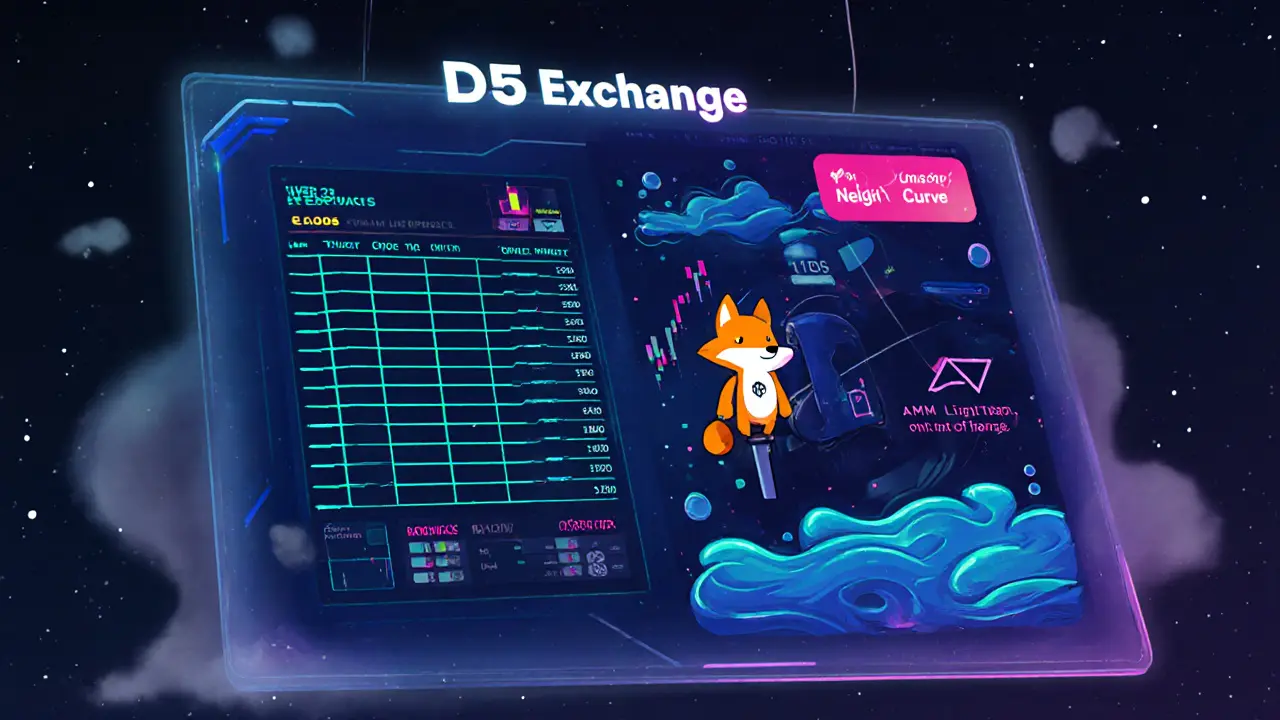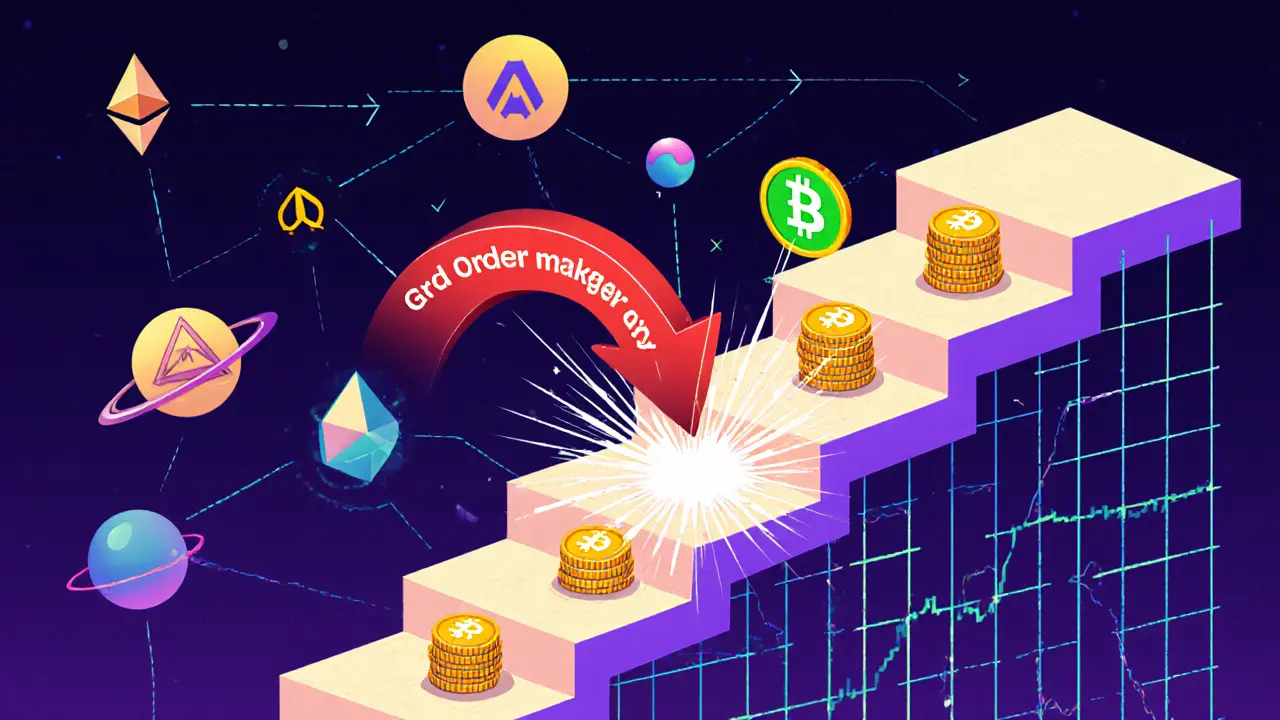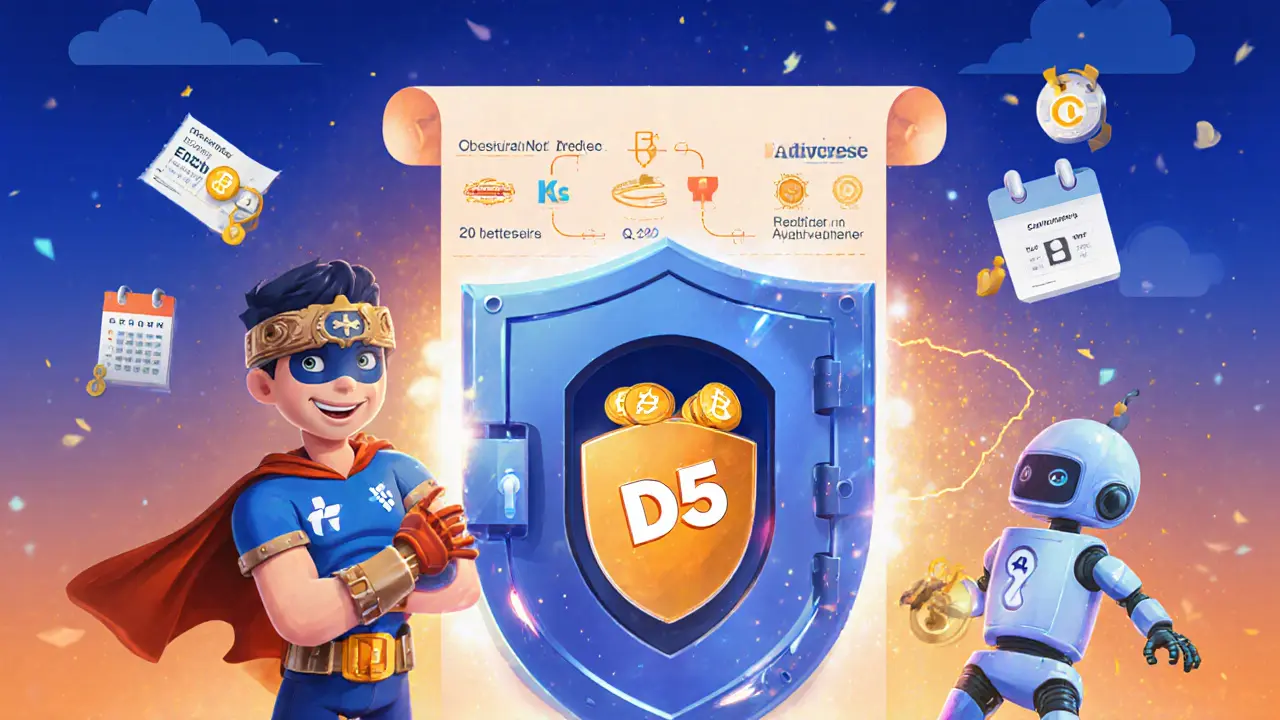
D5 Exchange Fee Calculator
Fee Structure Overview
Taker Fee
0.15% of trade value paid in traded token
Paid on every trade that takes liquidity from the grid
Maker Rebate
0.05% rebate paid in GDX token
Earned for placing liquidity orders on the grid
How Grid Trading Works:
With 0.05% grid granularity, your orders are placed at every 0.05% price step. For example, if ETH is at $3000:
- Maker order at $2998.50
- Maker order at $2997.00
- Maker order at $2995.50
- And so on...
When a taker order hits any grid line, it executes instantly with zero slippage.
D5 Exchange has been turning heads in the DeFi world since its launch in 2023. Combining an on‑chain order book with automated market‑making, it promises CEX‑like speed while keeping your assets in your own wallet. This review breaks down how it works, what you pay, and whether the hype matches reality.
TL;DR
- Hybrid DEX that merges order‑book precision with AMM liquidity.
- Zero slippage, no impermanent loss, but front‑running risk remains.
- Fees: 0.15% taker, 0.05% maker (rewards paid in GDX).
- Supports Ethereum L1 and L2s (Arbitrum, Optimism, Polygon, Avalanche).
- Best for traders who need fast execution and are comfortable with grid‑trading concepts.
What is D5 Exchange?
When you hear the name D5 Exchange is a decentralized cryptocurrency exchange that runs entirely on‑chain, blending a traditional order book with automated market maker (AMM) liquidity pools. Founded by the Gridex Protocol team in the UK, it launched commercially in March2023 and quickly positioned itself as the first platform to offer a fully on‑chain Grid Order Maker Book (GMOB) model.
Because every order lives on the blockchain, users never hand over custody to a central server. You keep full control of your ERC‑20 tokens from the moment you connect your wallet.
How the Hybrid Model Works
The core innovation is the Grid Order Maker Book (GMOB). Rather than matching market orders directly, the system slices a price range into discrete “grid steps” and places maker orders at each step. Traders choose one of three granularity levels:
- 0.01% grid - ideal for stablecoins where price moves are tiny.
- 0.05% grid - works well for mid‑volatility tokens like GDX.
- 0.30% grid - suited to high‑volatility assets.
When a taker order hits a grid line, it is executed instantly, eliminating slippage. The matching engine lives on Ethereum L1 or any supported Layer2, such as Arbitrum and Optimism, which cuts gas costs dramatically.
Behind the scenes, D5 aggregates external liquidity from protocols like Uniswap (V2/V3) and Curve Finance. If the internal grid cannot fill an order, the platform routes the remainder to these AMM pools, guaranteeing deep liquidity.
Fees, Rewards, and Tokenomics
D5’s fee schedule is simple:
- 0.15% taker fee (paid in the traded token).
- 0.05% maker fee, which is actually a rebate paid in the native GDX token.
The GDX token launched at $0.16 and spiked to $1.97 in its first month, a 1,100% surge. Its tokenomics allocate 30% of the 200million max supply to development and early investors, while 70% is reserved for community airdrops, staking, and maker rewards. The platform’s ongoing reward campaign on the GDX/ETH pair (0.05% grid) currently holds a 54million GDX prize pool.
Security and Custody
Because orders are stored on‑chain, there’s no central database to hack. You retain full custody of your assets, eliminating the counter‑party risk that plagues centralized exchanges (CEXs). The platform has undergone multiple audits (2023‑2024) and uses battle‑tested contracts from the Gridex codebase.
However, like any on‑chain order book, D5 is vulnerable to front‑running. Sophisticated bots can spot large grid orders and slip in ahead of them. The team mitigates this with a “commit‑reveal” scheme for large orders, but the risk remains higher than pure AMM designs.

Liquidity, Trading Pairs, and Network Support
At the time of writing, D5 supports:
- Ethereum mainnet, Arbitrum, Optimism, Polygon, Avalanche, and several emerging L2s.
- Core pairs: GDX/USDT, GDX/USDC, GDX/ETH, plus major stable‑coin/ETH grids.
- External liquidity routing to Uniswap V2/V3 and Curve, ensuring competitive pricing.
Volume is modest compared with Uniswap (which holds ~60% of DEX volume), but the platform’s order‑book model attracts professional traders who need precise price discovery.
Pros and Cons
| Pros | Cons |
|---|---|
| Zero slippage on grid trades | Front‑running risk for large orders |
| No impermanent loss | Learning curve for grid‑trading concepts |
| Full custody of assets | Relatively low total volume vs established DEXs |
| Maker rebates paid in GDX | Platform age - launched only in 2023 |
| Layer‑2 support reduces gas fees | Limited UI tutorials for beginners |
Step‑by‑Step: Getting Started on D5
- Install a Web3‑compatible wallet (MetaMask, Coinbase Wallet, or any WalletConnect‑enabled app).
- Navigate to d5.exchange and click “Connect Wallet”.
- Choose your network - Ethereum, Arbitrum, or Optimism are the cheapest for most trades.
- Deposit the ERC‑20 token you want to trade (e.g., USDT, GDX, ETH).
- Select a grid granularity (0.01%, 0.05% or 0.30%). The UI highlights recommended settings based on token volatility.
- Set your order size and click “Place Grid”. Your maker orders will appear instantly in the on‑chain book.
- Watch the “Live Trades” pane - taker orders match your grid lines with zero slippage.
- Collect maker rebates in GDX from the “Rewards” tab; you can stake them for additional yields.
How D5 Stacks Up Against Competitors
| Feature | D5 Exchange (Hybrid DEX) | Uniswap (Pure AMM) | Typical CEX (e.g., Binance) |
|---|---|---|---|
| Order Matching | On‑chain order book with grid mechanics | Liquidity pool swaps only | Centralized matching engine |
| Slippage | Zero (grid order fills at exact price) | Variable, can be high on large trades | Usually low, but depends on order book depth |
| Impermanent Loss | None - maker orders are static | Present for LPs | Not applicable (custodial) |
| Custody | User‑held (non‑custodial) | User‑held | Custodial (exchange holds assets) |
| Fees | 0.15% taker, 0.05% maker rebate | 0.30% (varies by pool) | 0.10%‑0.25% (tiered) |
| Front‑Running Risk | Moderate - mitigated by commit‑reveal | Low (automated pool pricing) | Low (centralized) |
Who Should Use D5 Exchange?
If you’re a trader who values zero slippage and wants to keep assets in your own wallet, D5 is a solid pick. It shines for grid‑style strategies, arbitrage between layers, and makers looking for GDX rebates. Beginners may find the grid settings confusing, so start with the 0.01% stablecoin grid and use the built‑in tutorials.
Future Roadmap and Outlook
The team is adding more Layer2 bridges (e.g., zkSync) and exploring cross‑chain order books that could bring Binance‑Smart‑Chain and Solana liquidity into the grid. Gas‑optimization upgrades are slated for Q22025, which should make tiny grid steps even cheaper. Analysts predict hybrid DEXes will capture a larger slice of the $10billion total DEX TVL as institutional traders demand professional tools without custody risk.

Frequently Asked Questions
Is D5 Exchange truly non‑custodial?
Yes. All orders and balances stay on the blockchain. You never deposit funds into a company‑owned wallet; your private key controls the assets at all times.
How does the grid system avoid slippage?
Each grid line is a preset price where a maker order sits. When a taker order hits that exact price, the trade executes instantly - there’s no price movement between order placement and execution, so slippage is zero.
What networks can I trade on?
Ethereum mainnet, Arbitrum, Optimism, Polygon, Avalanche and any future L2s the team integrates. Switching networks is done directly in the D5 UI.
Are there any hidden fees?
No hidden fees. The only costs are the explicit taker or maker fees shown before each trade. Gas fees apply per transaction, but using L2s dramatically reduces them.
Can I list my own token on D5?
Yes. D5 offers permissionless listing - simply add the token contract address and create a grid. The platform will aggregate external liquidity automatically.


Comments
Cindy Hernandez
Hey folks, just wanted to point out that D5’s taker fee of 0.15% is pretty standard compared to other CEXs, and the 0.05% maker rebate paid in GDX can actually offset some of those costs if you’re active market makers.
Also, the fee calculator they embed is handy for quick estimations – just plug in your trade size, pick taker or maker, and you get the exact amount in the token you’re trading.
Keep an eye on the network you’re using; gas fees on Ethereum can dwarf the 0.15% if the chain is congested.
Overall, it’s a decent setup for both spot traders and grid‑trading enthusiasts.
Alie Thompson
When dissecting the fee architecture of D5 Exchange, one cannot ignore the moral implications that lurk beneath the veneer of market efficiency. The platform advertises a modest 0.15% taker fee, yet this figure is presented without a transparent accounting of the externalities imposed upon the average user, particularly those who are unaware of the hidden costs embedded in network gas fees.
Moreover, the 0.05% maker rebate, dispensed exclusively in the native GDX token, raises ethical concerns about token lock‑in and the subtle coercion to hold an otherwise obscure asset simply to achieve marginal cost reductions.
One must ask whether such a rebate system truly benefits the trader or merely serves to inflate the liquidity of the platform’s own token, thereby enriching the issuers at the expense of the uninformed.
The practice of incentivizing liquidity provision with a rebate that is not interchangeable with more widely accepted currencies creates a two‑tiered user base: the savvy insider who understands GDX dynamics, and the everyday participant who inadvertently subsidizes the platform’s tokenomics.
Beyond the superficial veneer of competitive fees, the exchange’s reliance on specific networks-Ethereum Mainnet, Arbitrum, Optimism, Polygon, Avalanche-introduces disparate accessibility. Users tethered to high‑fee chains like Ethereum may find the nominal 0.15% fee eclipsed by soaring gas costs, effectively rendering the advertised rates deceptive.
In the realm of decentralized finance, transparency must be paramount, yet D5’s fee schedule, while numerically appealing, conceals the true cost of participation behind a maze of ancillary charges.
It is incumbent upon regulators and community watchdogs to scrutinize such structures, ensuring that what is marketed as a user‑friendly environment does not morph into a covert revenue extraction mechanism.
Furthermore, the lack of a clear, user‑centric guide that delineates the net cost after accounting for gas and token‑specific rebates suggests a disregard for the very individuals the platform claims to serve.
This omission is not merely an oversight; it is a systemic vulnerability that can be exploited by opportunistic actors seeking to profit from the opacity.
In an ecosystem that prides itself on decentralization and user empowerment, the onus is on exchanges like D5 to adopt overt disclosure practices, laying bare the comprehensive cost structure in a manner that is digestible for novices and experts alike.
Only then can the community assess whether the pricing truly aligns with principles of fairness and equity, rather than masquerading as a benign fee schedule while masking hidden burdens.
In conclusion, while the headline numbers may appear attractive, the underlying mechanics warrant a rigorous, ethically informed examination before entrusting one’s capital to the platform.
Samuel Wilson
From a coaching standpoint, the fee model on D5 is quite straightforward: the taker pays 0.15% and the maker enjoys a 0.05% rebate in GDX. This simplicity aids traders in calculating expected costs without excessive mental load. I would advise newcomers to start on a low‑volume grid on Polygon, where gas is minimal, to get comfortable with the rebate mechanism before scaling up on Ethereum.
Rae Harris
Yo, the D5 grid system is basically a meme‑coin hustler’s playground. You slap a 0.05% grid on GDX, watch maker orders snap like bots, and the taker fee feels like a tiny nudge. Just watch the slippage on busy networks, or you’ll be paying more in gas than in the actual fee. It’s all about the arbitrage spread, fam.
Donald Barrett
What a joke. D5 thinks charging a measly 0.15% makes them competitive, but they’re just milking the masses while hiding the real cost in gas fees. If you’re not a privileged insider, you’ll be paying peanuts in rebates while the platform pockets the rest. Don’t be a sucker.
Christina Norberto
One must question whether D5’s fee structure is a mere façade for deeper, perhaps even covert, extraction of value. The maker rebate paid exclusively in GDX could be a vector for market manipulation, subtly enforcing token hoarding while the network fees remain opaque. Such mechanisms may, in a broader systemic view, contribute to centralized power dynamics within ostensibly decentralized platforms.
Darren R.
Listen up!!! D5’s fee schedule is **NOT** a marketing gimmick!!! 0.15% taker fee? Pffft-just a *smidge* compared to what you’ll actually lose in gas!!! And that 0.05% rebate in GDX? It’s like giving you a coupon for a store you never shop at!!! 😂😂😂
Hardik Kanzariya
Hey everyone, I totally get the excitement about the grid trading feature. It’s a great way to automate strategies, especially if you’re new to the space. Just remember to keep an eye on the underlying network load-high congestion can turn a low‑fee setup into a costly endeavor. Happy trading!
Shanthan Jogavajjala
Alright, let’s cut to the chase: D5’s fee model is just another layer of protocol‑level micro‑taxation. You think 0.15% is tiny? Add the L1 gas surcharge and you’re basically paying double‑digit percentages. If you’re not encrypting your trades, you’re basically handing over fees to the platform’s custodial vault.
Millsaps Delaine
It is evident upon careful examination that D5 Exchange, in its quest to present an ostensibly benevolent fee architecture, merely masks a sophisticated stratagem aimed at engendering a veneer of user‑centricity while subtly incentivising the accumulation of its proprietary token, GDX. The modest‑looking 0.15% taker fee, when juxtaposed against the often‑overlooked expenses associated with on‑chain transaction costs, reveals an asymmetry that favours the platform’s liquidity providers. Moreover, the 0.05% rebate, denominated exclusively in GDX, functions as a tacit mechanism for token lock‑in, thereby compelling traders to internalise value within the ecosystem rather than extracting it externally. Such a construct, while couched in the language of “rebate,” effectively serves as a fiscal conduit directing capital toward the exchange’s native asset, thereby reinforcing its market dominance. In sum, the purported simplicity of D5’s fee schedule belies a nuanced, multi‑dimensional approach to revenue generation that warrants scrutiny from both regulators and the broader crypto community.
Jack Fans
Hey team, D5’s fee calculator is actually pretty handy-just input your trade size and you get a clear breakdown. I’ve used it for a few grid runs on Polygon and it saved me a lot of guesswork. Theres a minor bug where the network dropdown sometimes resets, but overall it’s a solid tool. Keep up the good work!
Adetoyese Oluyomi-Deji Olugunna
D5’s interface is sophisitcated but often confusdng-especially the fee calculator. I wish they had more context on gas cost versus the 0.15% fee. Also, the rebate in GDX seems like a clever move to keep us locked in.
Krithika Natarajan
D5’s grid system works well if you keep an eye on the network fees. Simplicity is key.
Ayaz Mudarris
In evaluating the D5 Exchange fee structure, one must adopt a methodical approach that accounts for both direct transaction costs and ancillary network expenditures. The taker fee, delineated at 0.15%, is competitive when contextualised within the broader market, yet its impact is significantly modulated by the prevailing gas prices on the selected blockchain. Conversely, the maker rebate of 0.05% payable in GDX introduces a nuanced incentive mechanism that may yield net cost reductions for participants who maintain persistent liquidity provision. It is advisable for traders to conduct a comprehensive cost‑benefit analysis, factoring in the stochastic nature of gas fees across Ethereum, Arbitrum, Optimism, Polygon, and Avalanche, to ascertain the optimal network for execution. Ultimately, a disciplined assessment will elucidate whether D5’s fee paradigm aligns with the trader’s strategic objectives.
Irene Tien MD MSc
Is anyone else wondering why D5 suddenly decided to hand out rebates in GDX? It’s like they’re trying to push a secret agenda-perhaps to fund a clandestine moon‑base or something. Either way, the whole thing reeks of a controlled experiment, and the 0.15% taker fee is just the cherry on top of the conspiracy cake. 🤔
kishan kumar
In the grand tapestry of decentralized exchanges, D5’s fee model could be seen as a subtle ode to market equilibrium. The 0.05% maker rebate, expressed in GDX, invites participants to contemplate the nature of value creation within a protocol‑centric ecosystem. :)
Anthony R
D5’s fees are decent.
Vaishnavi Singh
Contemplating the fee structures of modern exchanges reveals the delicate balance between incentive and extraction; D5’s model offers a modest case study in this ongoing dialectic.